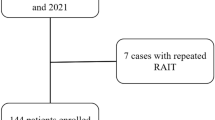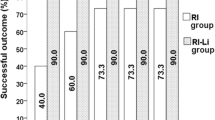Abstract
Background: There is a lack of data regarding the timing and particularly the severity of hypothyroidism post radioiodine (RI). Aim: To investigate the timing and severity of hypothyroidism in RI-treated hyperthyroid patients. Methods: Retrospective examination of the records of 183 RI-treated hyperthyroid patients (79 autoimmune hyperthyroidism, 46 toxic multinodular goiter, and 58 hyperthyroidism of indeterminate etiology). Results: One hundred and fifty-nine patients requiring a single dose of RI (435 MBq), 107 (67%) developed hypothyroidism. Hypothyroidism detected in: 16% of patients at <8 weeks, 46% at 8 to <16 weeks, 24% at 16 to <24 weeks, 9% at 24 to <36 weeks, 3% at 36 to <52 weeks, and 2% at >52 weeks. One hundred and eighty-three patients had follow-up after one or more doses of RI and 124 (68%) patients developed hypothyroidism; of these, 44 (36%) had TSH>50 mU/l and 34 (27%) had free T4<5 pmol/l when hypothyroidism was first detected. Of those patients with a delayed outpatient visit (no.=77) and those with an outpatient visit within the recommended target interval (no.=47), median TSH was 23 (0.05–152) mU/l and 32 (0.05–150) mU/l, respectively (p=0.75) and median free T4 was 7.1 (1.3–16.7) pmol/l and 6.6 (1.3–15.4) pmol/l, respectively (p=0.21) at first detection of hypothyroidism. Conclusions: The severity of hypothyroidism when first detected during follow-up is of concern and suggests that closer monitoring of thyroid function is required, particularly during the first 6 months post-RI therapy.
Similar content being viewed by others
References
Patel NN, Abraham P, Buscombe J, Vanderpump MPJ. The cost-effectiveness of treatment modalities for thyrotoxicosis in a UK centre. Thyroid 2006, 16: 593–8.
Royal College of Physicians. Radioiodine in the management of benign thyroid disease: clinical guidelines. Report of a Working Party. London: RCP, 2007.
Metso S, Jaatinen P, Huhtala H, Luukkaala T, Oksala H, Salmi J. Long-term follow-up study of radioiodine treatment of hyperthyroidism. Clin Endocrinol (Oxf) 2004, 61: 641–8.
Ahmad AM, Ahmad M, Young ET. Objective estimates of the probability of developing hypothyroidism following radioactive iodine treatment of thyrotoxicosis. Eur J Endocrinol 2002, 146: 767–75.
Boelaert K, Syed AA, Manji N, et al. Prediction of cure and risk of hypothyroidism in patients receiving 131I for hyperthyroidism. Clin Endocrinol 2009, 70: 129–38.
Nakajo M, Tsuchimochi S, Tanabe H, Nakabeppu Y, Jinguji M. Three basic patterns of changes in serum thyroid hormone levels in Graves’ disease during the one-year period after radioiodine therapy. Ann Nucl Med 2005, 19: 297–308.
Hennell S, Spark E, Wood B, George E. An evaluation of nurse-led rheumatology telephone clinics. Musculoskeletal Care 2005, 3: 233–40.
Shaida N, Jones C, Ravindranath N, et al. Patient satisfaction with nurse-led telephone consultation for the follow-up of patients with prostate cancer. Prost Cancer Prost Dis 2007, 10: 369–73.
Aizawa Y, Yoshida K, Kaise N, et al. The development of transient hypothyroidism after iodine-131 in hyperthyroid patients with Graves’ disease: prevalence, mechanism and prognosis. Clin Endocrinol 1997, 46: 1–5.
Walter MA, Briel M, Christ-Crain M, et al. Effects of antithyroid drugs on radioiodine treatment: systematic review and meta-analysis of randomised controlled trials. BMJ 2007, 334: 514–7.
Weetman AP. Radioiodine treatment for benign thyroid diseases. Clin Endocrinol (Oxf) 2007, 66: 757–64.
Walter MA, Schindler C, Christ-Crain M, Müller-Brand J, Müller B. Different strategies to overcome the effect of carbimazole on high- and low-dose radioiodine therapy: results from continuous dose-effect models. Eur J Clin Invest 2009, 39: 51–7.
Murphy E, Mehta S, Gannon D, Bassett JHD, Frank J, Meeran K. Telephone follow-up following radioiodine therapy for thyrotoxicosis improves outcome. Endocrine Abstracts 2002, 3: P301.
Skennerton S, Nijher GMK, Dhillo WS, Meeran K. Use of a telephone clinic to follow up patients treated with radioactive iodine for thyrotoxicosis. Endocrine Abstracts 2006, 12: P130.
Munday L. Post radioiodine monitoring: do patients feel telephone consultations are an acceptable part of a nurse-led clinic? Endocrine Abstracts 2009, 19: P343.
Author information
Authors and Affiliations
Corresponding author
Rights and permissions
About this article
Cite this article
Peacey, S.R., Kumar, S., Wright, D. et al. The follow-up of radioiodine-treated hyperthyroid patients: Should thyroid function be monitored more frequently?. J Endocrinol Invest 35, 82–86 (2012). https://doi.org/10.3275/7807
Accepted:
Published:
Issue Date:
DOI: https://doi.org/10.3275/7807




